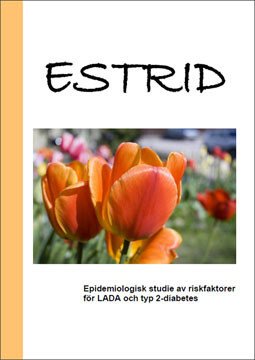Study design
The aim of ESTRID is to study how lifestyle factors and heredity influence the risk of LADA compared to type 2 diabetes. The project is also expected to render new knowledge about the interaction between genes and lifestyle in the development of type 2 diabetes.
It has been shown that many adults who previously would have been diagnosed with type 2 diabetes actually suffer from a type of diabetes more similar to type 1 diabetes. This type of diabetes has been labelled LADA (latent autoimmune diabetes in adults). Why some people suffer from LADA and others from type 2 diabetes is something we currently know very little about.
ANDIS
In 2008, a new diabetes registry called ANDIS (All New Diebetics in Scania) was introduced in the county of Scania in southern Sweden. The goal is to register all new cases of diabetes in Scania and describe the spectrum of subgroups that diabetes encompasses in detail. By doing so, the hope is to be able to better diagnose and treat different types of diabetes. In 2012, a similar registry called ANDiU (All New Diabetics in Uppsala) was introduced in the county of Uppsala. ANDIS and ANDiU constitute the foundation for the ESTRID study.

The questionnaire
Since little is known about which factors influence the risk for LADA, we ask broadly about lifestyle factors and health conditions which may be of significance. Among other things, we would like to find out whether known risk factors for type 2 diabetes, such as a sedentary lifestyle, overweight and smoking also influence the risk of developing LADA. We are also interested in the possible significance of allergies, infections, vaccinations and diet as well as how lifestyle factors in combination with heredity influence the risk for LADA and type 2 diabetes.
Study design
The ESTRID study started in 2010 and is a case-control study, meaning we compare cases with diabetes to controls without diabetes. We invite all individuals with LADA registered in ANDIS and, since 2012, all individuals with LADA registered in ANDiU as well. For every LADA case, we invite four type 2 cases from the respective registries as well as six individuals from the general population, matched for county and age, to act as controls. Without these control cases, we would not be able to see whether lifestyle differs between individuals who have developed diabetes and those who haven't. Everyone who accepts to participate in the study is asked to fill out a questionnaire in which heredity and lifestyle are mapped out. Our goal is to include more than 3000 individuals with diabetes in the study and a matching number of controls.
In the diagram below you can see how many individuals have participated in the ESTRID study since its beginning in september 2010. Thus far, more than 5600 respondents have contributed to the study. Out of these, more than 3000 are individuals with diabetes and more than 2600 are controls without diabetes. The response rate is almost 80% among cases with diabetes and above 60% among controls, which we consider a very good result! Among the participants, 53% are male and 47% are female.

Translation
For those who wish, there is the possibility to complete a version of the questionnaire in Arabic or Serbo-Croatian. These two languages are, after Swedish, the two most common native languages in Scania.
